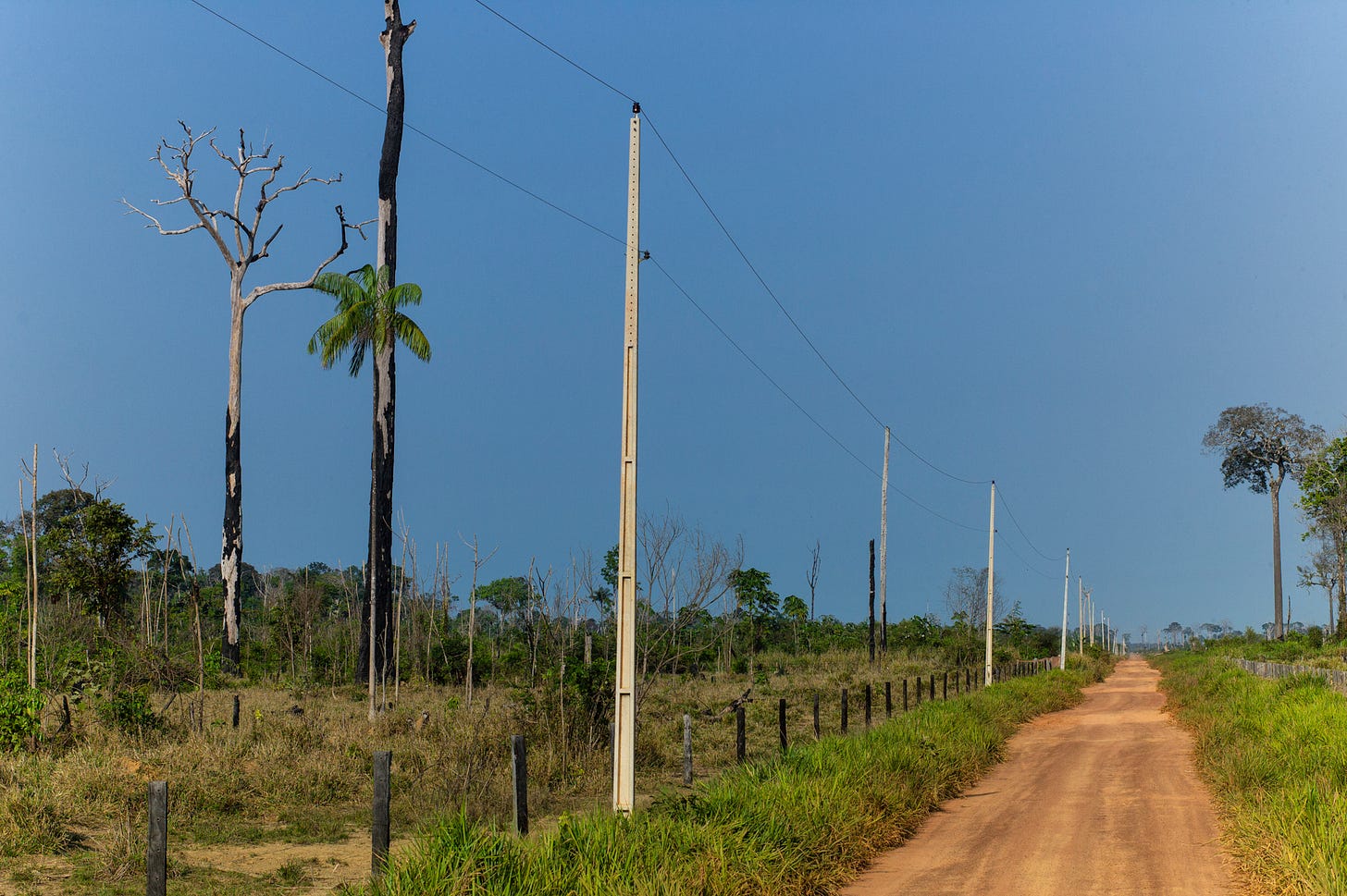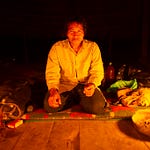For previous chapters click here
The speed with which the flames grew was astonishing. Sweeping quickly across the leaf litter and jumping up to a dead palm frond that lay directly above, they spat and crackled, reaching head height within seconds. Buxo and Dino whooped loudly, and across the forest Magila and Zezinho replied. They were wired, full of nerves, and I felt exactly the same.
‘Wind, do your thing!’ shouted Dino loudly.
I followed Buxo and Dino, photographing them as they lit more fires among the dry, dead undergrowth. Dino laughed at me – ‘He doesn’t want to do it, does he?’ – which made Buxo grin as he sprayed more dark liquid out across the leaf litter. Soon the roar of the fire became deafening and the heat unbearable as the flames licked fifteen, twenty, thirty feet high. I stayed close, shooting constantly through my old Leica for as long as I could before the intense heat started singeing my eyebrows and the hair on my hands and I had to leap back. I hopped through the tangle from tree trunk to tree trunk, trying to take shots of the fire, but every time I framed up I’d be pushed further back by the heat.
Within ten minutes we were watching a huge, boiling hellfire, which moved with terrifying ferocity. Flames ripped up the few tall trees that remained standing, fuelled by the dessicated trunks of those beneath them. Smaller trees were overcome in seconds and the tops of palms exploded as flames hit their dried fronds and fruits. Dino and his boys patrolled the edges, lighting more fires and calling instructions to one another.
‘In five years or so we’ll be raising cattle and have meat,’ Dino shouted to me through the crackle and roar of the flames.
I tried to smile, to share his moment, but I couldn’t.
Gavin took me aside to interview me sitting on a log, backdropped by a wall of raging orange. I didn’t know what to say, so just to placate him I mumbled some shit, nothing that really meant anything beyond the cliché of watching a catastrophe unfold. I had invested months of my life, navel gazing my way across the Amazon to figure out what to do with my tiny patch of land, and here we were burning a far larger area of forest with – a few nerves aside – all the lack of concern and mundane routine of popping out for the weekly shop. Dino and his family were easily the most environmentally destructive bunch of people I’d ever met, yet I adored them and, try as I might, I couldn’t find a bone in my body to criticise them.
The following morning Gavin and I walked through the blackened waste shooting pictures – me of the forest, him of me. There was nothing left, just a smouldering wasteland pricked by the charcoal shards of trees that had died making their last stand. A few still glowed but most just smouldered. I didn’t speak. I didn’t know what to say. I stood for a while allowing the hot ground to burn the soles of my boots, shooting a portrait of a carbon-black trunk. It reminded me of a totem pole, alone on a battlefield the morning after the day before. The image was wretched and awful, the tree’s heart orange against the ghastly black, fuelling a few flames that licked its edges, the sky beyond darkened by pillars of smoke as they released their carbon.
The drive back though endless farmland to the Peruvian border took hours. We watched from the window, all of us silent, at a land denuded, a wasteland of ragged fields strung with fences and spotted with white cattle. Occasional islands of forest loomed up, holding out against the vast, empty, charred expanses in which the blackened skeletons of enormous trees stood like awful monuments deliberately left as shrines to what was lost. I hadn’t seen deforestation on this scale since years earlier in Borneo. It’s all a fucking disgrace to the world.
The following day we took a boat from Puerto Maldonado up the Madre de Dios, heading back to my land. The curtain of forest that ran along the edge of the mighty river was thick and lush, the monkeys and birds returned to the trees as we motored beyond the towns and gold mines that lined the beaches. We stopped in Boca Manu to ease our sore arses and take a brief lunch of fried chicken and beer, then headed on towards Atalya, a small village another few hours up beyond the confluence of the Manu River.
The Alto Madre de Dios ran fast on that final stretch as its gradient rose towards the Andes, the river’s ferocity only tempered by its endless concertina. As we passed the village of Diamante and came around the back of another long bend, the boatman suddenly started shouting ‘Mira, mira’ and pointing excitedly up river. As he turned us across the current we scanned the banks, assuming he’d spotted a jaguar. ‘No contactados!’, he exclaimed, his finger indicating something we hadn’t yet spotted. I lifted my binoculars and scanned along the bank, until I hit on the shapes of people standing on the far side against the tangle of the forest.
‘Slow down, slow down,’ shouted Gavin as he pointed his camera, which he’d propped onto the wooden rim of the boat to steady his shot. ‘Nobody move,’ he barked.
We all fell silent and the boatman dropped the outboard to a gentle chug to hold us in the current. On a small beach across the water, perhaps a hundred yards away, stood a group of women. I lifted my telephoto lens up to meet them and as they came into focus, my jaw dropped. There they were, the Mascho Piro, the uncontacted people. Four young women – girls really – naked bar their small bark skirts, stood watching us. Below them an older woman, bent double, was washing a small baby on the edge of the river.
I checked the settings on my camera and ramped up my shutter speed to fight the movement of the boat and my pounding heart. The old woman noticed us and whisked the baby away into the thick forest, while the four girls walked along the beach, watching us.
I tracked them through my lens as they climbed onto a large dead tree trunk. One of them removed a necklace from around her neck and quickly tucked it into the back of her skirt, out of sight, as the others started shouting and waving to us. We had no idea what they were saying as nobody spoke their language and we knew we shouldn’t reply anyway. Instead we maintained our distance, not wanting to get any closer. Two of the girls stepped down from the tree and vanished into the forest, leaving two who continued watching us as we shot pictures and film of them. It felt kind of gross, taking their pictures with the cold-hearted objectifying gaze of a paparazzo, while not responding to them in any way. They watched us for a minute and then, for a split second, just before they hopped off the log and vanished, both girls held their hands up to their mouths. Whether it was a gesture that represented apprehension and surprise, or just a fortuitous and irrelevant moment, I’ll never know. But I hit the shutter and captured it.
The boatman sped up and we all exploded into a kind of hysteria, as if that very moment we’d won the World Cup. We’d just seen the Mascho Piro, the most famous of the uncontacted tribes! Aggressive and secretive! A tribe who struck fear into the hearts of every other tribe in the region! A tribe that had remained almost completely isolated from the outside world, one of just a handful of similar tribes left in the Amazon – and indeed the world!
But within a few minutes Gavin’s excitement subsided. ‘We’re not on fucking safari,’ he barked at us, completely killing our euphoria. ‘You know what we’re doing? We’re fetishising these people.’
I had no idea what he was talking about, but he went on to explain – at great length, and in words I could barely understand – that our excitement was just grotesque voyeurism of a group of people that we had burdened with our own romantic myths and longings, none of which were likely to be true. In hindsight, of course, he was right; our reaction was quite absurd. But none of that meant anything to me back then, as I knew nothing about Indigenous people.
I scrolled through my photos checking they were sharp as we passed a beach a mile or so upriver, where the same Mascho Piro had killed a local guy called Shaco a few years earlier by shooting him in the chest with an arrow. Since then other people, including local Yine and missionaries, had tried to make contact. One government official had even handed someone from the tribe a half-finished bottle of Coke from his boat, an act so careless he could have killed them all if he’d had influenza or anything else to which they lacked immunity.
The true story of the Mascho Piro is one of brutality and genocide that stemmed from the rubber boom at the end of the nineteenth century, when the tribe, who refused to become slaves, were slaughtered in such numbers that their blood turned the Manu River red. They vanished into the forest and have remained there ever since, isolated by generational stories and trauma. The Mascho Piro live in the forest no more than twenty miles from my land as the crow flies, and perhaps little more than two hundred miles from Dino’s farm. The land that lies between, straddling the border of Peru and Brazil, is home to more isolated tribes than anywhere else on earth.
When I began to click through the photos on my laptop that evening, my heart sank. Trying to keep focus and framing my shots while hand-holding an 800mm lens on a moving boat had turned out to be trickier than I’d anticipated. Most of the images suffered from motion blur and the auto-focus had struggled to cope with the movement, leaving me with a hundred or so shots that were pretty much unusable. One image, however, stood out, and it was head and shoulders above the rest. It was just beautiful – a delicate portrait of the two remaining girls standing on the log, lit by the afternoon sun against a lush green backdrop of balsa trees. Their eyes stare straight into the lens, their hands covering their mouths, giving the image a power that asked so many more questions than it could ever possibly answer.
In the next instalment I go to the forest spirits with Ayahuasquero Don Alberto and see a world made of toffee Lego.










Share this post